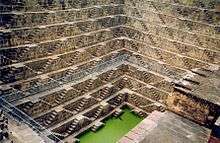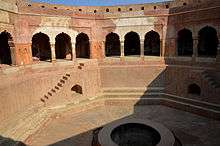Stepwell



Stepwells are wells or ponds in which the water may be reached by descending a set of steps. They may be covered and protected and are often of architectural significance. They also may be multi-storied having a bullock which may turn the water wheel ("rehat") to raise the water in the well to the first or second floor.
They are most common in western India. They may be also found in the other more arid regions of South Asia, extending into Pakistan. The construction may be utilitarian, but sometimes includes significant architectural embellishments.
All forms of the stepwell are examples of the many types of storage and irrigation tanks that were developed in India, mainly to cope with seasonal fluctuations in water availability. A basic difference between stepwells on the one hand, and tanks and wells on the other, was to make it easier for people to reach the ground water, and to maintain and manage the well.
In some related types of structure (johara wells), ramps were built to allow cattle to reach the water.
The builders dug deep trenches into the earth for dependable, year-round groundwater. They lined the walls of these trenches with blocks of stone, without mortar, and created stairs leading down to the water.[1] The majority of surviving stepwells originally also served a leisure purpose, as well as providing water. This was because the base of the well provided relief from daytime heat, and more of such relief could be obtained if the well was covered. Stepwells also served as a place for social gatherings and religious ceremonies. Usually, women were more associated with these wells because they were the ones who collected the water. Also, it was they who prayed and offered gifts to the goddess of the well for her blessings.[1] This led to the building of some significant ornamental and architectural features, often associated with dwellings and in urban areas. It also ensured their survival as monuments.
Stepwells usually consist of two parts: a vertical shaft from which water is drawn and the surrounding inclined subterranean passageways, chambers and steps which provide access to the well. The galleries and chambers surrounding these wells were often carved profusely with elaborate detail and became cool, quiet retreats during the hot summers.[2]
Names
A number of distinct names, sometimes local, exist for stepwells. In Hindi-speaking regions, they include names based on baudi (including bawdi, bawri, baoli, bavadi, bavdi). In Gujarati and Marwari language, they are usually called vav or vaav (Gujarati: વાવ). Other names include kalyani or pushkarani (Kannada: ), bawdi (Rajasthani: बावड़ी), baoli (Hindi: बावली) and barav (Marathi: बारव).
History


The step well may have originated to ensure water during periods of drought. The water is considered sacred from the time of Vedas and the steps to reach water level in artificially construed reservoirs can be found in the sites of Indus Valley Civilization such as Dholavira and Mohenjo-daro.[3] Mohenjo-daro has 'cylindrical brick lined wells' which may be the predecessors of the step well.[4] The first rock-cut step wells in India date from 200-400 AD.[5]
The earliest example of bath-like pond reached by steps is found at Uperkot caves in Junagadh. These caves are dated to the 4th century. Navghan Kuvo, a well with circular staircase, in vicinity is an another example. It is possibly built in Western Satrap (200-400 AD) or Maitraka (600-700 AD) period though some place it as late as the 11th century. Nearby Adi Kadi ni Vav is constructed either in second half of the 10th century or 15th century.[6]
The stepwells at Dhank in Rajkot district are dated to 550-625 AD. The stepped ponds at Bhinmal (850-950 AD) are followed by it.[5] The stepwells were constructed in the south western region of Gujarat around 600 AD from there it spread north to Rajasthan and subsequently to north and west India. Initially used as an art form by Hindus, the construction of these stepwells hit its peak during Muslim rule from the 11th to 16th century.[2]
One of the earliest existing example of stepwells was built in the 11th century in Gujarat, the Mata Bhavani's Stepwell. A long flight of steps leads to the water below a sequence of multi-story open pavilions positioned along the east/west axis. The elaborate ornamentation of the columns, brackets and beams are a prime example of how stepwells were used as a form of art.[7]
The Mughal rulers did not disrupt in the culture that was practiced in these stepwells and encouraged the building of stepwells. The authorities during the British Raj found the hygiene of the stepwells less than desirable and had installed pipe and pump systems to replace their purpose.[7]
Significance
The stepwell ensures availability of water during the period of drought. The stepwells had social, cultural and religious activities significance.[7] These stepwells were proven to be well-built sturdy structures, after withstanding earthquakes.[1]
Details
Many stepwells have ornamentation and details as elaborate as those of Hindu temples. Proportions in relationship to the human body were used in their design, as they were in many other structures in Indian architecture.[8]
In India
Numbers of surviving stepwells can be found in North Karnataka (Karnataka), Gujarat, Rajasthan, Delhi, Madhya Pradesh, and Maharashtra. Significant ones include:





- Chandinath ki Bawadi, Bhinmal
- Daadeli Vav, Bhinmal
- Agrasen ki Baoli, New Delhi
- Rajon ki baoli, New Delhi
- Chand Baori in Abhaneri near Jaipur, Rajasthan
- Jachcha Ki Baori, Hindaun City in Hindaun Block, Rajasthan
- Charthana Barav, Parbhani District, Maharashtra
- Rani ki vav at Patan, Gujarat
- Adalaj ni Vav at Adalaj, Gandhinagar, Gujarat
- Dada Harir Stepwell, Ahmedabad
- Toor Ji Ki Baori, Jodhpur
- Birkha Bawari, Jodhpur
- Bhoot Baori, Jodhpur
- Shahi Baoli, Lucknow
- Raniji ki Baori in Bundi, Rajasthan; Bundi has over 60 baolis in and around the town.
In Karnataka
- Stepped Well or Pushkarani near Mahanavami dibba Hampi or Vijayanagara, North Karnataka
- Stepped Well at Manikesvara Temple Lakkundi, North Karnataka
- Nagakunda Sudi, North Karnataka
- Venkatappa Naik royal bath Kanakagiri, North Karnataka
- Stepwell at Mallikarjuna temple complex and another Stepwell, Aihole, North Karnataka
In Pakistan
Stepwells from Mughal periods still exist in Pakistan. Some are in preserved conditions while others are not.
- Rohtas Fort, near Jhelum
- Wan Bhachran, near Mianwali
- Losar Baoli, near Islamabad
- Losar Baoli, Sher Shah Park Wah Cantt
- Makli Baoli, near Thatta
Stepped ponds

Stepped ponds are very similar to stepwells in terms of purpose but it is important to recognize the difference between these two types of structures. For example, stepped ponds were always built to accompany a nearby temple while stepwells were positioned away from noisy sites and future tourist attractions.[9] While stepwells are dark and barely visible from the surface, stepped ponds are illuminated with the light from the sun. Also, stepwells are quite linear in design compared to the rectangular shape of stepped ponds.[8]
Influence
Stepwells are certainly one of India's most unusual, but little-known, contributions to architecture. They influenced many other structures in Indian architecture, especially many that incorporate water into their design.[2] Ram Bagh in Agra was the first Mughal garden in India.[8] It was designed by Mughal emperor Babur and reflected his notion of paradise not only through water and landscaping, but also through symmetry by including a reflecting pool in the design. Naturally, he was also very entranced by stepwells and felt that one would complement the garden of his palace and built a baoli in Agra Fort. Many other Mughal gardens include reflecting pools to enhance the landscape or as an elegant entrance. Additional famous gardens that incorporate water into their design include:
- Humayun's Tomb, Nizamuddin East, Delhi
- Taj Mahal, Agra
- Mehtab Bagh, Agra
- Safdarjung's Tomb
- Shalimar Bagh (Srinagar), Jammu and Kashmir
- Nishat Gardens, Jammu and Kashmir
- Yadvindra Gardens, Pinjore
- Khusro Bagh, Allahabad
- Roshanara Bagh
- Brindavan Gardens, Mysore, Karnataka (1927-1932)
- Rashtrapati Bhavan, New Delhi (1911-1931)
Notes
- 1 2 3 Shekhawat, Abhilash. "Stepwells of Gujarat". India's Invitation. Retrieved 30 March 2012.
- 1 2 3 Davies, Philip (1989). The Penguin guide to the monuments of India. London: Viking. ISBN 0-14-008425-8.
- ↑ Takezawa, Suichi. "Stepwells -Cosmology of Subterranean Architecture as seen in Adalaj" (pdf). The Diverse Architectural World of The Indian Sub-Continent. Retrieved 2009-11-18.
- ↑ Livingston & Beach, page 19
- 1 2 Livingston & Beach, page xxiii
- ↑ Jutta Jain-Neubauer (1981). The Stepwells of Gujarat: In Art-historical Perspective. Abhinav Publications. pp. 19–25. ISBN 978-0-391-02284-3.
- 1 2 3 Tadgell, Christopher (1990). The History of Architecture in India. London: Phaidon Press. ISBN 0-7148-2960-9.
- 1 2 3 Livingston, Morna (2002). Steps to Water: The Ancient Stepwells of India. New York: Princeton Architectural. ISBN 1-56898-324-7.
- ↑ Jain-Neubauer, Jutta (1981). The Stepwells of Gujarat: In Art-historical Perspective. New Delhi: Abhinav. ISBN 0-391-02284-9.
References
- Rima Hooja: "Channeling Nature: Hydraulics, Traditional Knowledge Systems, And Water Resource Management in India – A Historical Perspective". At infinityfoundation.com
- Livingston, Morna & Beach, Milo (2002). Steps to Water: The Ancient Stepwells of India. Princeton Architectural Press. ISBN 1-56898-324-7.
- Jutta Jain Neubauer The Stepwells of Gujarat: An Art-historical Perspective (2001)
- Morna Livingston Steps to Water: The Ancient Stepwells of India (Princeton 2002)
- Philip Davies, The Penguin guide to the monuments of India, Vol II (London: Viking, 1989)
- Christopher Tadgell, The History of Architecture in India (London: Phaidon Press, 1990)
- Abhilash Shekhawat, "Stepwells of Gujarat." India's Invitation. 2010. Web. 29 March 2012. <http://www.indiasinvitation.com/stepwells_of_gujarat/>.
- Stepwells in India at DMOZ
- "Architecture of the Indian Subcontinent - glossary". Indoarch.org. Retrieved 2006-12-18.
External links
| Wikimedia Commons has media related to Stepwells. |

